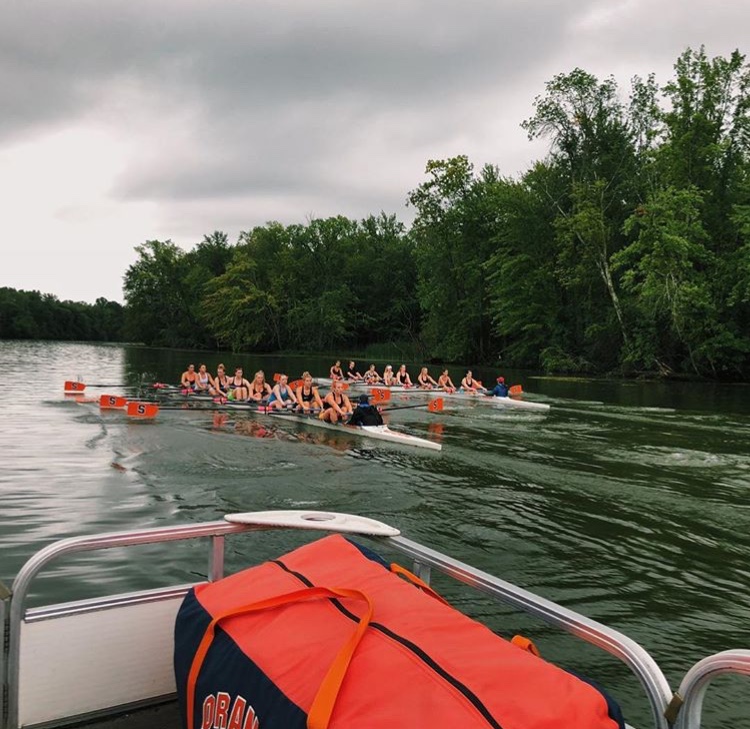
NAT sound of coxswain coaching her rowers
Loftus: College rowing teams at Universities around the country rise before dawn to train on the water. According to scholarship-stats-dot-com, division one women’s rowing is made up of 88 different teams from different schools, totaling over 4,000 division one rowers. The average team has nearly 50 athletes, yet teams are only allowed to give out 20 full scholarships. This leaves the majority of the roster to be filled out by a lesser-known group of college athletes — the walk-ons.
The two rowers one after another saying their names and that they are walk-ons — ends “Syracuse rowing team”
Loftus: Claire Kuehnel is the coach for walk-ons for the Syracuse University Women’s rowing team.
Kuehnel: Walk-ons are super important to rowing.
Loftus: The Syracuse University Women’s rowing team is one of the nation’s premier programs, finishing top-15 in 2017’s coaches poll.
NAT of announcers
Loftus: That’s from the 2018 Head of the Charles Regatta. And like many other top programs, the Orange rowing team relies heavily on walk-ons to fill out their roster.
Kuehnel: They call rowing the ultimate walk-on sport.
Loftus: Many walk-on rowers at the college level have had very little experience in the past with the sport. This makes for a unique recruiting process for teams.
Kuehnel: I know that I walk around and like see tall women and want to run up to them and say ‘hey, do you want to row?’
According to scholarship-stats-dot-com, less than 40 percent of college rowers actually did the sport in high school. This means many come from other athletic backgrounds.
Rowers: All throughout high school I swam and played water polo. In high school I played volleyball, basketball and lacrosse.
Loftus: These newly minted rowers don’t just have long days on the rowing machine
NAT of Erg, brought up here then goes under next track, to be brought up slightly during next SOT.
Loftus: But the classroom as well.
Rowers: Our mornings start at 5-50 we catch the bus to the boathouse then we have practice until about 9-30 and then I have class. And then I have three classes and then a workout again from 5 to 6. I probably don’t go to sleep until like 11-30. I try to go to bed as early as possible but with homework and everything it ends up being around midnight.
Loftus: The challenges of balancing sport and life is the same for both walk-ons and scholarship athletes. And of course there is a learning curve for scholarship athletes to compete at the next level, but Coach Keunell says it takes a long time for walk-ons to find their stride.
Kuehnel: Generally, I would say it takes about a full year of training to kinda understand how to utilize your body the best way you can.
Loftus: Those without scholarships feel the need to keep up with those who do — in the boat and on the rowing machine.
Rowers: I think I’m still trying to reach the level of the recruited rowers.
Loftus: Just getting on the water isn’t the only struggle. Even if you do find success as a walk-on, you may not be able to keep it for reasons beyond rowing.
Rowers: My major is elementary education so we have a lot of time in the classroom, and because the classroom hours kind of clash with the rowing hours I might not be able to fit in both. If I potentially got injured to the point where it would, my back would not let me do it I would definitely not risk it.
Loftus: So no glory, tough practices, always proving themselves and impossible schedules to balance. From this it seems all work and no fun in the life of a walk-on.
Rowers: Every erg test where we just sit on the erg for six thousand meters and have to go until we black out I don’t want to do it any more.
Loftus: But as these athletes see it, there’s more to it than winning championships and getting recognition.
Rowers: I like the people that I’ve met and the friends that I’ve made. I do it because I genuinely like the sport of rowing now. Whenever I tell people that I walked on, they asked if I rowed in high school, and I am always proud to tell them I didn’t because it’s just a new level of just stepping into something new that maybe people around you have more experience but you can reach their level in the end. I didn’t really expect to get anything out of it I kinda just wanted to make the team — and I did — and then I was just kinda hoping to survive on the team.
Loftus: But these two walk-ons have done more than just survive. Both earned seats in varsity boats, and as a result, they helped their team get a top-15 finish at a race this fall. I’m Daniel Loftus.
Walk-ons are the lifeblood of the sport of rowing. As this piece explores, it’s not an easy job being a non-scholarship athlete, and one may not get out of it what they expect. Daniel Loftus spoke with walk-on rowers and a coach (who was a former walk-on) on the Syracuse women’s rowing team about what it’s like to live the life of a walk-on rower.




